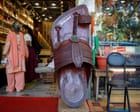

Italian luxury brand Prada is facing accusations of cultural appropriation after showcasing sandals in its Spring/Summer 2026 menswear collection that closely resemble traditional Kolhapuri chappals from India. The sandals, priced at approximately ₹1 lakh or $1,200, sparked outrage among Indian netizens who felt the brand was cashing in on their culture without giving due credit to the artisans behind the original design.
Kolhapuri chappals are handcrafted leather sandals traditionally made by artisans in the Kolhapur district of Maharashtra and parts of Karnataka. These sandals, believed to have originated centuries ago, are known for their distinctive braided leather straps, intricate cutwork, durable construction, and timeless craftsmanship. Kolhapuri chappals aren't just footwear; they represent regional identity and craftsmanship, involving a completely manual manufacturing process that uses vegetable-tanned leather and traditional knowledge passed down through generations. In 2019, after advocacy by artisan groups, they were granted a Geographical Indication (GI) tag, protecting products originating from a specific region and known for their unique features.
The controversy arose when Prada initially labeled the sandals as "leather sandals" without acknowledging their Indian origin. This perceived "erasure of origin" led to accusations of cultural appropriation, with many pointing out the vast price disparity between Prada's sandals and the original Kolhapuri chappals, which sell for around ₹1,000 in India. The incident ignited a debate about the exploitation of artisan communities and the importance of protecting traditional crafts.
Following the backlash, Prada admitted that its sandals were inspired by traditional Indian handcrafted footwear with a centuries-old heritage. Lorenzo Bertelli, Prada Group Head of Corporate Social Responsibility, expressed the company's deep recognition of the cultural significance of Indian craftsmanship and its commitment to responsible design practices. He also mentioned the designs were still in the early stages and not confirmed for production.
The controversy has brought the fine line between inspiration and appropriation in fashion into focus, highlighting the need for respectful engagement with artisan communities. Critics argue that luxury brands often borrow indigenous motifs and crafts for profit without acknowledging their origins, reframing them as "exotic" or "avant-garde" while leaving out Indian artisans. This incident has reignited calls for legal safeguards and ethical collaborations to protect centuries-old crafts from exploitation by luxury brands. Some experts note that unless brands explicitly use the term 'Kolhapuri', or imply a direct link, there is little legal recourse for cultural appropriation.
The incident underscores the economic struggles of Indian artisan communities, who often face shrinking markets and competition from factory-made imitations. While luxury fashion profits from their craft's cultural cachet, these communities remain invisible, underpaid, and excluded from global markets. There are approximately 15,000-20,000 artisans involved in Kolhapuri chappal production, a sharp decline from previous decades.
The Prada controversy has amplified the growing global conversation about decolonizing fashion, ethical consumption, and the rights of indigenous artisans. As the world increasingly values sustainable, handmade, and heritage products, ensuring that the benefits of such trends reach their original creators is not just a cultural concern but a matter of economic justice. Some local artisans expressed pride in their craftsmanship gaining international recognition. The Maharashtra business body is considering patenting Kolhapuri chappals for protection from infringement.